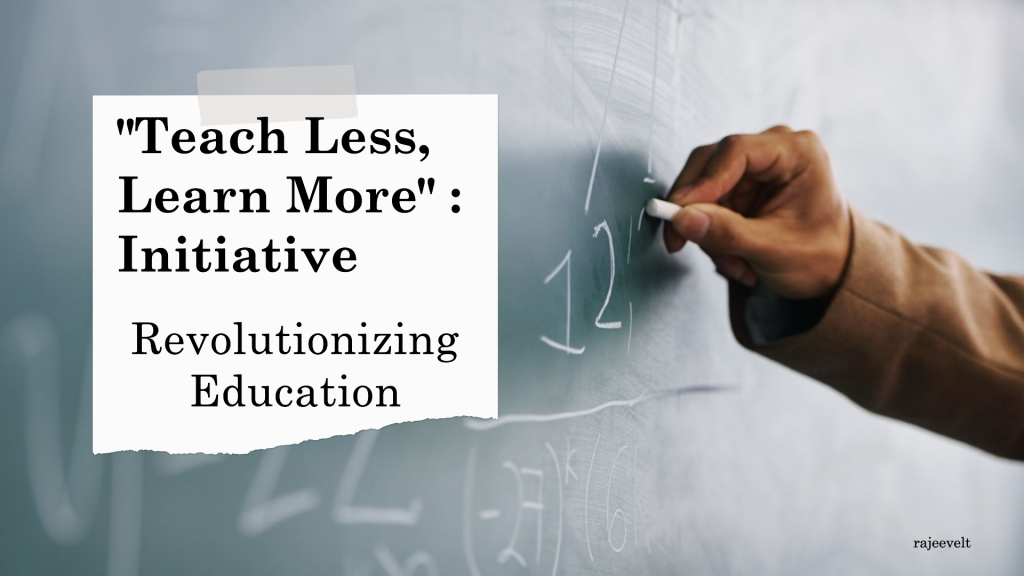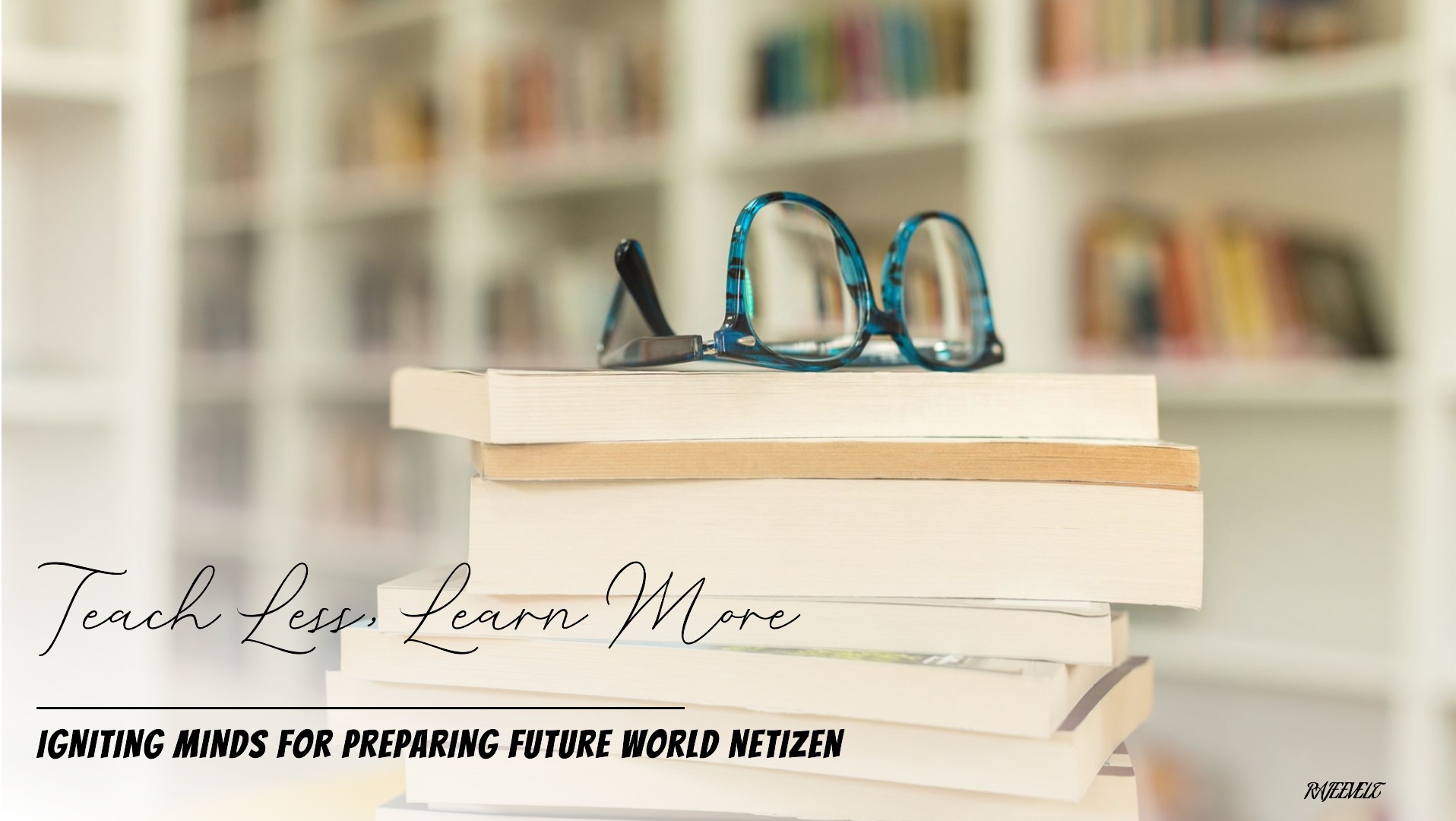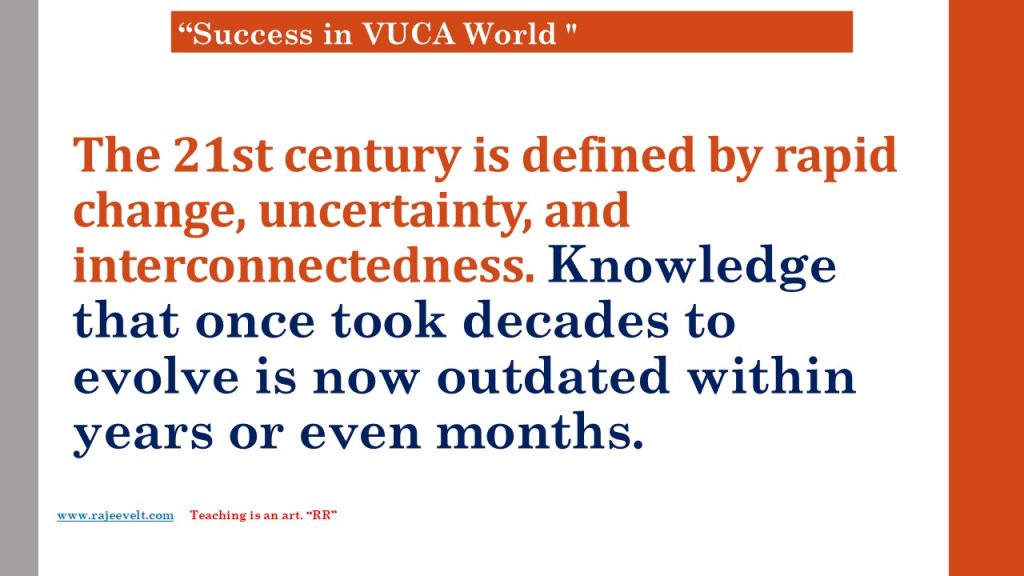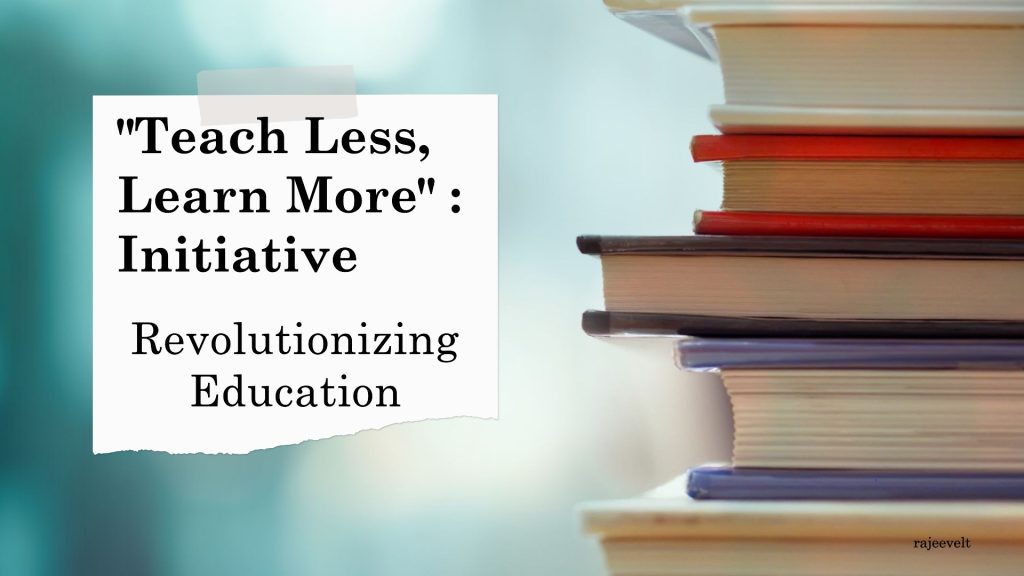
“Teach Less, Learn More” Theory in the 21st Century
Education is no longer confined to the simple transfer of knowledge from teacher to student in the 21st century. With the explosion of information, the rise of digital technologies, and the demands of a rapidly changing global economy, traditional content-heavy teaching has become less effective. The philosophy of “Teach Less, Learn More” (TLLM) addresses this shift by emphasizing depth over breadth, understanding over memorization, and critical thinking over rote learning. TLLM empowers students to engage actively with knowledge rather than passively receive it in a world where creativity, adaptability, problem-solving, and lifelong learning have become essential skills. This approach equips learners to deal with complexities, collaborate across cultures, and innovate in uncertain environments. TLLM stands as a timely response to the evolving educational landscape, integrating pedagogy with the skills and mindsets that the 21st century requires.
How the Theory Helps Educators
The TLLM approach transforms teaching from a race to cover the syllabus into a journey of inspiring meaningful learning for educators. Teachers can devote more time to designing interactive lessons, developing curiosity, and guiding students to think independently. This shift reduces burnout by enabling teachers to act as facilitators and mentors rather than mere transmitters of information. It also opens space for innovation—teachers can integrate project-based learning, real-world problem-solving, and digital tools to make lessons more engaging and relevant. The educators cultivate classrooms where students take ownership of their learning, ask critical questions, and connect knowledge across disciplines. Teachers experience greater professional satisfaction, seeing their role evolve into that of a coach who shapes not only academic success but also character, creativity, and lifelong learning habits.
“The Importance of Teach Less, Learn More in the 21st Century- How It Empowers Educators”
Introduction
The Shifting Landscape of Education
The 21st century has brought about dramatic transformations in the way societies learn, work, and connect. With rapid globalization, digital innovations, and the explosion of knowledge accessible at our fingertips, the traditional classroom model that focused primarily on content delivery has become increasingly insufficient. Education is no longer about how much information a student can memorize; it is about how effectively learners can process, apply, and extend their knowledge in real-life contexts. Employers, parents, and policymakers alike now recognize that creativity, problem-solving, adaptability, and collaboration matter as much as—if not more than—mere factual recall (Trilling & Fadel, 2009).
The philosophy of “Teach Less, Learn More” (TLLM) emerges as both timely and necessary. The concept, popularized in Singapore’s education reforms in the early 2000s, emphasizes the idea that when teachers reduce the emphasis on rote teaching and content-heavy delivery, students are freed to engage more meaningfully in deep learning experiences (Ng, 2008). TLLM advocates for prioritization far from suggesting that less is learned —teaching fewer topics but with greater depth, and ensuring that learners develop essential skills and dispositions for the future.
The central promise of TLLM is compelling: by teaching less in terms of volume and breadth, educators create more opportunities for students to inquire, reflect, and construct their own understanding. This shift is particularly crucial in the 21st century, where the half-life of knowledge is shrinking and learners must constantly adapt to new challenges. TLLM provides a framework for making education more relevant, sustainable, and empowering—for both students and teachers.


Understanding the Philosophy of Teach Less, Learn More
The “Teach Less, Learn More” approach challenges long-standing assumptions about education. Traditionally, schooling has been dominated by the principle of coverage: teachers are expected to deliver a fixed curriculum, often overloaded with content, within a rigid timeline. Students, in turn, are expected to absorb and reproduce this information in examinations. This model, however, often prioritizes surface learning—short-term memorization that fades quickly—over the deep, critical engagement that leads to transferable understanding.
TLLM proposes an alternative vision. It redefines success in terms of quality of learning instead of equating effective teaching with the sheer quantity of content covered,. Teachers are encouraged to identify the “big ideas” and enduring understandings within their subject areas and focus their efforts on cultivating those through active, student-centered pedagogies (Fullan & Langworthy, 2014). Teaching less does not mean neglecting rigor; rather, it means streamlining content to emphasize what truly matters for the learner’s intellectual and personal growth.
The “learn more” dimension of the philosophy shifts the spotlight onto students. It calls for a transformation of their role from passive recipients of information to active constructors of knowledge. This involves encouraging inquiry-based learning, nurturing dialogue and debate, integrating real-world problem-solving tasks, and leveraging technology to promote independent exploration. TLLM adopts habits of curiosity, persistence, and adaptability—traits that are indispensable in the 21st century (Zhao, 2012).
The dual focus of teaching less and learning more, therefore, is not contradictory but complementary. Teachers streamline content and shift away from excessive lecturing, which frees up time for deeper student engagement. In doing so, classrooms become spaces where knowledge is not merely transmitted but co-constructed. The result is a richer, more meaningful educational experience that aligns with the broader demands of our age.
Relevance of TLLM in the 21st Century
The 21st century is defined by rapid change, uncertainty, and interconnectedness. Knowledge that once took decades to evolve is now outdated within years or even months. Schools cannot simply aim to transmit fixed sets of facts in such an environment; they should instead develop students who are capable of learning how to learn. The TLLM philosophy directly responds to this reality by integrating education with the demands of our age.
TLLM emphasizes the development of future-ready skills. Scholars often refer to the “4Cs” of 21st-century competencies: critical thinking, creativity, collaboration, and communication (Partnership for 21st Century Skills, 2019). These skills cannot be cultivated in classrooms dominated by rote memorization and teacher-centered instruction. They require opportunities for dialogue, experimentation, reflection, and inquiry. Educators gain the time and flexibility to design tasks by teaching less content, that nurture these essential competencies.
TLLM addresses the challenge of information overload. The digital revolution has made information instantly accessible, but not all of it is reliable or meaningful. Students should therefore develop the ability to filter, evaluate, and synthesize knowledge from multiple sources. This calls for deeper learning experiences that move beyond “what to think” toward “how to think.” TLLM provides the conditions for this by shifting away from excessive curricular coverage and focusing instead on cultivating information literacy and metacognition (Kirschner & van Merriënboer, 2013).
TLLM is consistent with global trends in education reform. Nations such as Finland, Singapore, and Canada have demonstrated that less prescriptive curricula and more student-centered approaches yield stronger educational outcomes. These systems recognize that overloading students with content often diminishes engagement and creativity. Instead, they prioritize depth, inquiry, and the holistic development of the learner (Sahlberg, 2015). For countries seeking to reimagine their education systems, TLLM provides both a philosophical foundation and a practical strategy.
TLLM responds to the growing call for personalized learning. In the 21st century, one-size-fits-all education is increasingly inadequate. Students differ not only in their abilities and interests but also in the contexts in which they learn. Teachers can allocate more time to differentiated instruction, ensuring that each learner’s strengths and needs are addressed. This personalized approach helps learners connect more deeply with knowledge and develop confidence in their abilities.
TLLM is not just relevant—it is essential. It reflects a philosophy of education that is in harmony with the challenges and opportunities of our time.


How the Theory Helps Educators
While much of the conversation around TLLM centers on student outcomes, its impact on teachers is equally profound. In fact, one of the most compelling reasons to adopt this philosophy is the way it empowers educators to succeed in their professional roles.
TLLM reduces the burden of content delivery. Teachers often feel pressured to “cover” every aspect of a dense curriculum in traditional classrooms, leaving little room for exploration or reflection. This relentless pace can lead to stress, fatigue, and diminished enthusiasm for teaching. TLLM lightens this load by streamlining content and emphasizing essentials. This frees teachers to engage more deeply with fewer topics, allowing them to focus on pedagogy rather than racing against the clock (Hogan, 2014).
The approach redefines the role of the teacher. Rather than acting as mere transmitters of knowledge, educators become facilitators, mentors, and co-learners. This shift not only benefits students but also enhances professional satisfaction for teachers. They can design interactive lessons, encourage inquiry, and witness the joy of discovery in their classrooms. TLLM restores the artistry of teaching by giving educators the creative freedom to innovate.
TLLM supports continuous professional growth. When teachers adopt student-centered practices such as project-based learning or inquiry-driven instruction, teachers are encouraged to expand their repertoire of skills. They learn to integrate technology meaningfully, design interdisciplinary projects, and cultivate reflective dialogue. These practices not only enrich the classroom experience but also strengthen the educator’s identity as a lifelong learner (Darling-Hammond et al., 2020).
TLLM has the potential to reduce teacher burnout. When teachers are no longer constrained by the pressure to deliver vast amounts of content, they can focus on fostering genuine engagement. This results in more interactive, fulfilling classroom experiences, which in turn reinforce teachers’ sense of purpose and accomplishment. A more balanced workload also leaves space for collaboration among colleagues, enabling teachers to share best practices and build supportive professional communities.
The TLLM philosophy aligns with teachers’ deeper aspirations. Most educators enter the profession not to produce exam scores but to shape lives. When a teacher teaches less and creates room for more authentic learning, she can nurture critical thinkers, compassionate individuals, and responsible citizens. This alignment between philosophy and practice reignites passion and meaning in the profession.
TLLM is not only an educational reform for students but also a transformative framework for educators. It honours their expertise, expands their professional agency, and helps them reclaim joy in the teaching-learning process.
Impact on Students
The true measure of any educational philosophy lies in its impact on learners. The Teach Less, Learn More (TLLM) framework reshapes the student experience by shifting the focus from memorization to meaningful engagement. This transformation is both immediate and long-term, affecting how they learn in the present and how they continue learning beyond the classroom.
TLLM encourages students to move from being passive recipients of information to active participants in the learning process. Students often sit silently in traditional classrooms, while teachers explain and deliver content. Their role is largely reactive, limited to taking notes or preparing for examinations. Under TLLM, however, students are given the space to inquire, question, and explore. This nurtures ownership of learning, cultivating curiosity and intrinsic motivation (Bransford, Brown, & Cocking, 2000).
TLLM promotes deeper understanding. When less content is covered, students have the opportunity to engage with essential concepts at greater depth. They can analyse, evaluate, and apply knowledge rather than skim superficially across multiple topics. Research has consistently shown that deeper engagement enhances retention and transferability, equipping students to apply what they know in unfamiliar contexts (Hattie, 2009). This prepares them not merely for examinations but for life-long problem-solving.
The philosophy nurtures critical thinking and creativity. Freed from the constraints of rote memorization, students can spend more time grappling with open-ended questions, designing projects, and proposing solutions to real-world issues. This kind of learning mirrors the demands of the modern workplace, where innovation and adaptability are highly prized (Robinson, 2011).
TLLM supports personalized learning experiences. Because teachers are not rushed to “cover” vast amounts of material, they can attend to the diverse learning needs and styles of their students. This inclusivity ensures that struggling learners receive the support they need, while advanced learners are challenged to stretch their thinking. Students begin to see themselves not in comparison to others, but as unique learners on individual journeys.
TLLM prepares students for lifelong learning. The 21st century demands individuals who can continuously learn, unlearn, and relearn. By cultivating inquiry, resilience, and reflective practices, TLLM equips learners with the habits and mindsets necessary to thrive in a world of constant change.
In essence, the student experience under TLLM is not about doing less, but about learning better. Students emerge not only with knowledge but with the skills and dispositions to navigate an unpredictable future.


Practical Applications and Classroom Strategies
The philosophy of TLLM is inspiring, but its power lies in practical application. Educators often ask: How can this be realized in daily teaching? Fortunately, there are multiple strategies that bring the principles of TLLM to life.
1. Project-Based Learning (PBL)
PBL is one of the most effective ways to implement TLLM. The teachers design projects instead of teaching abstract content in isolation, that require students to apply concepts to real-world problems. A science unit on ecosystems might culminate in a project where students design sustainable community gardens. Such tasks demand research, collaboration, and critical thinking—hallmarks of deeper learning (Thomas, 2000).
2. Inquiry-Driven Learning
Inquiry shifts the classroom dynamic from teacher-directed instruction to student-led exploration. Teachers pose guiding questions and provide resources, while students investigate, experiment, and present their findings. This method aligns closely with TLLM by reducing the time spent on lectures and increasing opportunities for discovery and discussion.
3. Flipped Classrooms
Direct instruction happens outside of class through videos or readings in a flipped classroom model, freeing up in-class time for collaborative problem-solving and application activities. This reduces the need for repetitive lecturing and allows students to actively engage with concepts, ask questions, and deepen understanding during class (Bergmann & Sams, 2012).
4. Integration of Technology
Digital tools offer immense potential to support TLLM. Platforms for simulations, interactive assessments, and online collaboration help students take ownership of their learning. A mathematics teacher might use adaptive learning software that adjusts to a student’s pace, while class time is reserved for higher-order problem-solving.
5. Assessment for Learning (AfL)
Traditional examinations often encourage shallow learning aimed at short-term recall. Under TLLM, assessments should align with deeper learning goals. Strategies such as formative assessments, peer feedback, reflective journals, and portfolios provide richer insights into student progress. These methods shift assessment from a measure of memorization to an opportunity for growth (Black & Wiliam, 1998).
6. Cross-Disciplinary Learning
Real-world problems rarely fall neatly into subject boundaries. TLLM encourages cross-disciplinary projects where students can apply knowledge from multiple fields i.e. a unit on climate change could integrate science, geography, economics, and ethics, helping students see the interconnectedness of knowledge.
7. Slowing Down to Go Deeper
Perhaps the most radical application of TLLM is simply slowing down. Instead of rushing through multiple topics, teachers choose fewer units but explore them thoroughly. This practice helps students cultivate mastery, resilience, and reflective habits.
These strategies demonstrate that TLLM is not an abstract theory but a practical philosophy. It empowers teachers to design meaningful experiences and equips students to learn in ways that are engaging, relevant, and enduring.
Global Perspectives and Case Studies
The philosophy of Teach Less, Learn More (TLLM) is not confined to one nation or system; it resonates across the globe. Different countries have embraced versions of this philosophy, demonstrated how reducing content overload and emphasized deep learning can transform education.
Singapore: The Birthplace of TLLM
Singapore introduced the TLLM initiative in 2004 under then-Prime Minister Lee Hsien Loong’s vision of shifting education “from quantity to quality.” The Ministry of Education reduced curriculum load and emphasized creative, inquiry-based teaching (Ng, 2008). Teachers were encouraged to innovate, while schools were given greater autonomy to design learning experiences. The results were striking: Singaporean students consistently performed at the top of international assessments such as PISA, not only in content knowledge but also in problem-solving and collaborative skills (OECD, 2018). The initiative showed that focusing on depth rather than breadth does not compromise academic rigor; it enhances it.
Finland: Less Pressure, More Learning
Finland’s education system offers another compelling example. Finnish schools are famous for shorter school days, minimal standardized testing, and a curriculum that emphasizes holistic development. Teachers are trusted professionals who enjoy autonomy in designing lessons that foster creativity and critical thinking. Despite teaching fewer hours and having less exam pressure, Finnish students consistently achieve high levels of literacy, numeracy, and scientific literacy (Sahlberg, 2015). Finland demonstrates that reducing formal instruction and focusing on student well-being leads to deeper, more sustainable learning outcomes.
United States: The Shift Toward Deeper Learning
In the United States, the deeper learning movement has parallels with TLLM. Schools adopting project-based learning models, such as those in the High-Tech High network in California, encourage students to engage in long-term interdisciplinary projects. Students may design and present solutions to environmental challenges in their communities. These approaches reduce the emphasis on test preparation and foster creativity, collaboration, and civic responsibility (Mehta & Fine, 2019). While implementation varies, the philosophy reflects a growing recognition that “teaching more” is not synonymous with “learning more.”
India: Emerging Practices
India presents a different context, where content-heavy curricula and high-stakes exams dominate. However, pockets of innovation are emerging. The National Education Policy (NEP) 2020 explicitly emphasizes reducing curricular overload, integrating experiential learning, and prioritizing conceptual understanding over rote memorization (Government of India, 2020). Many progressive schools in India are experimenting with inquiry-based models, interdisciplinary learning, and activity-driven pedagogy. While challenges remain in scaling these practices across a vast system, the direction aligns closely with the TLLM philosophy.
These global examples affirm that TLLM is not only desirable but also feasible. Different contexts show that when schools reduce emphasis on sheer coverage and focus instead on meaningful engagement, student learning outcomes improve in both quality and depth.


Challenges and Opportunities
While the benefits of TLLM are clear, the journey to implementation is not without obstacles. Educators, policymakers, and stakeholders must navigate challenges carefully to realize its full potential.
1. Teacher Mindset and Readiness
One of the greatest challenges lies in shifting teacher mindsets. Many educators are accustomed to equating effective teaching with content coverage. Moving toward facilitation, inquiry, and student agency requires professional development and support. Teachers should feel confident experimenting with new methods without fear of failure (Hogan, 2014).
2. Curriculum and Assessment Structures
Even if teachers embrace TLLM, rigid curricula and exam-oriented systems can act as barriers. High-stakes testing often reinforces rote memorization and discourages innovation. Assessments should evolve to measure skills like critical thinking, collaboration, and creativity. Countries that have succeeded with TLLM, such as Finland, have restructured their evaluation systems to align with deeper learning outcomes.
3. Parental and Societal Expectations
Parents equate education with academic rigor and exam success. They may resist approaches that appear to “teach less,” fearing that students will fall behind. Overcoming this perception requires transparent communication about the philosophy and its benefits, as well as evidence of improved student engagement and achievement.
4. Equity and Access
TLLM demands resources, training, and flexibility—conditions not equally available in all schools. Without careful planning, the benefits of this philosophy might be unevenly distributed, widening gaps between privileged and under-resourced institutions. Equity must therefore remain central to policy and practice.
5. Opportunities for Transformation
TLLM gives schools many opportunities. Teachers rethink their roles. Schools adopt innovative pedagogies. Policymakers restructure curricula and encourage interdisciplinary learning. Parents support schools and communities join hands with them. Schools build a culture of deep learning. Educators align technology with pedagogy. They create personalized and student-centered environments. They prepare learners for the modern world. Challenges exist, but they are not impossible. Leaders provide vision. Leaders show commitment. Schools overcome obstacles. Education systems become more meaningful. Education systems become more equitable.
Conclusion:
The philosophy of Teach Less, Learn More (TLLM) is not simply an educational reform; it is a profound reimagining of what learning means in the 21st century. Education can no longer be about the mechanical transfer of knowledge in a world marked by rapid technological change, complex global challenges, and an abundance of accessible information. Instead, it should empower learners to think critically, act creatively, and adapt continuously. TLLM provides the foundation for such a transformation.
It means shifting from surface memorization to deeper, more meaningful learning that nurtures curiosity, resilience, and lifelong adaptability for students. It means a release from the treadmill of content coverage and a rediscovery of the artistry of teaching for educators. Teachers become facilitators, mentors, and co-learners, shaping environments where inquiry, dialogue, and reflection thrive. For education systems, it means aligning curricula, pedagogy, and assessments with the skills and dispositions required for the future.
Yes, challenges remain—curricular rigidity, exam pressures, teacher readiness, and societal expectations all demand careful navigation. Yet, global case studies from Singapore, Finland, the United States, and India show that transformation is not only possible but also profoundly rewarding. Schools that embrace TLLM are not producing “less learning”; they are nurturing deeper understanding, stronger competencies, and richer human potential.
The 21st century demands courageous educators and visionary policymakers who are willing to break from outdated models. We teach less and students learn more. We reduce rote content and students get space for creativity. Students practice problem-solving. Students build collaboration. We shift focus from coverage to connection. We move from memorization to meaning. We prepare learners for exams. We also prepare learners for life.
The educators should champion TLLM not as a slogan but as a living philosophy. Each lesson redesigned, each assessment reimagined, and each classroom transformed becomes a step toward a future where education is not about filling minds but about igniting them. If we dare to teach less, we can empower our students—and ourselves—to learn infinitely more.
References
- Bergmann, J., & Sams, A. (2012). Flip your classroom: Reach every student in every class every day. International Society for Technology in Education.
- Black, P., & Wiliam, D. (1998). Assessment and classroom learning. Assessment in Education: Principles, Policy & Practice, 5(1), 7–74.
- Bransford, J. D., Brown, A. L., & Cocking, R. R. (Eds.). (2000). How people learn: Brain, mind, experience, and school. National Academy Press.
- Darling-Hammond, L., Flook, L., Cook-Harvey, C., Barron, B., & Osher, D. (2020). Implications for educational practice of the science of learning and development. Applied Developmental Science, 24(2), 97–140.
- Fullan, M., & Langworthy, M. (2014). A rich seam: How new pedagogies find deep learning. Pearson.
- Government of India. (2020). National Education Policy 2020. Ministry of Human Resource Development.
- Hattie, J. (2009). Visible learning: A synthesis of over 800 meta-analyses relating to achievement. Routledge.
- Hogan, D. (2014). Why is Singapore’s school system so successful, and is it a model for the West? The Conversation.
- Kirschner, P. A., & van Merriënboer, J. J. (2013). Do learners really know best? Urban legends in education. Educational Psychologist, 48(3), 169–183.
- Mehta, J., & Fine, S. (2019). In search of deeper learning: The quest to remake the American high school. Harvard University Press.
- Ng, P. T. (2008). Educational reform in Singapore: From quantity to quality. Educational Research for Policy and Practice, 7(1), 5–15.
- OECD. (2018). PISA 2018 results. Organisation for Economic Co-operation and Development.
- Partnership for 21st Century Skills. (2019). Framework for 21st century learning. Battelle for Kids.
- Robinson, K. (2011). Out of our minds: Learning to be creative. Capstone.
- Sahlberg, P. (2015). Finnish lessons 2.0: What can the world learn from educational change in Finland? Teachers College Press.
- Thomas, J. W. (2000). A review of research on project-based learning. Autodesk Foundation.
- Trilling, B., & Fadel, C. (2009). 21st century skills: Learning for life in our times. Jossey-Bass.
- Zhao, Y. (2012). World class learners: Educating creative and entrepreneurial students. Corwin.


